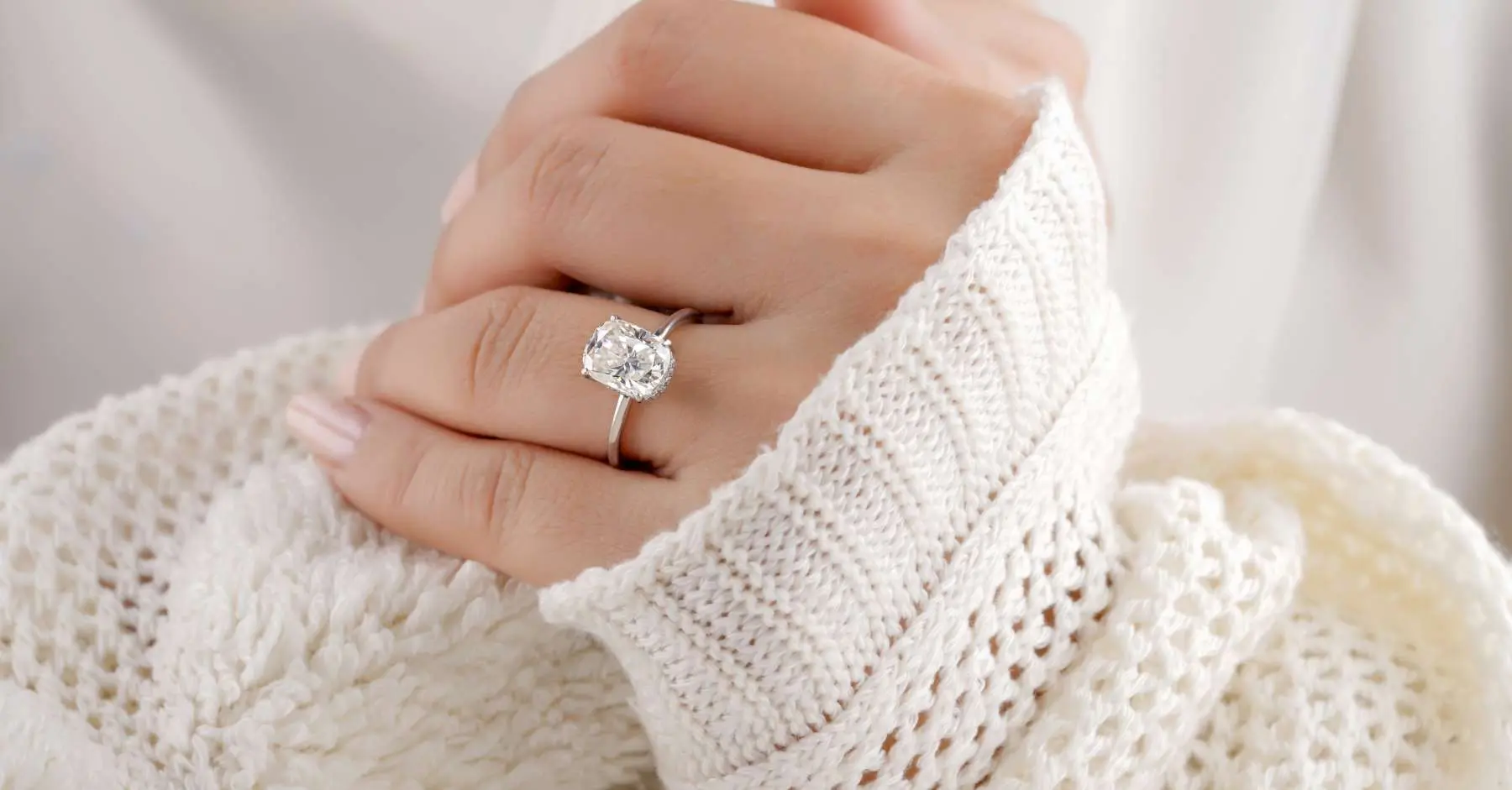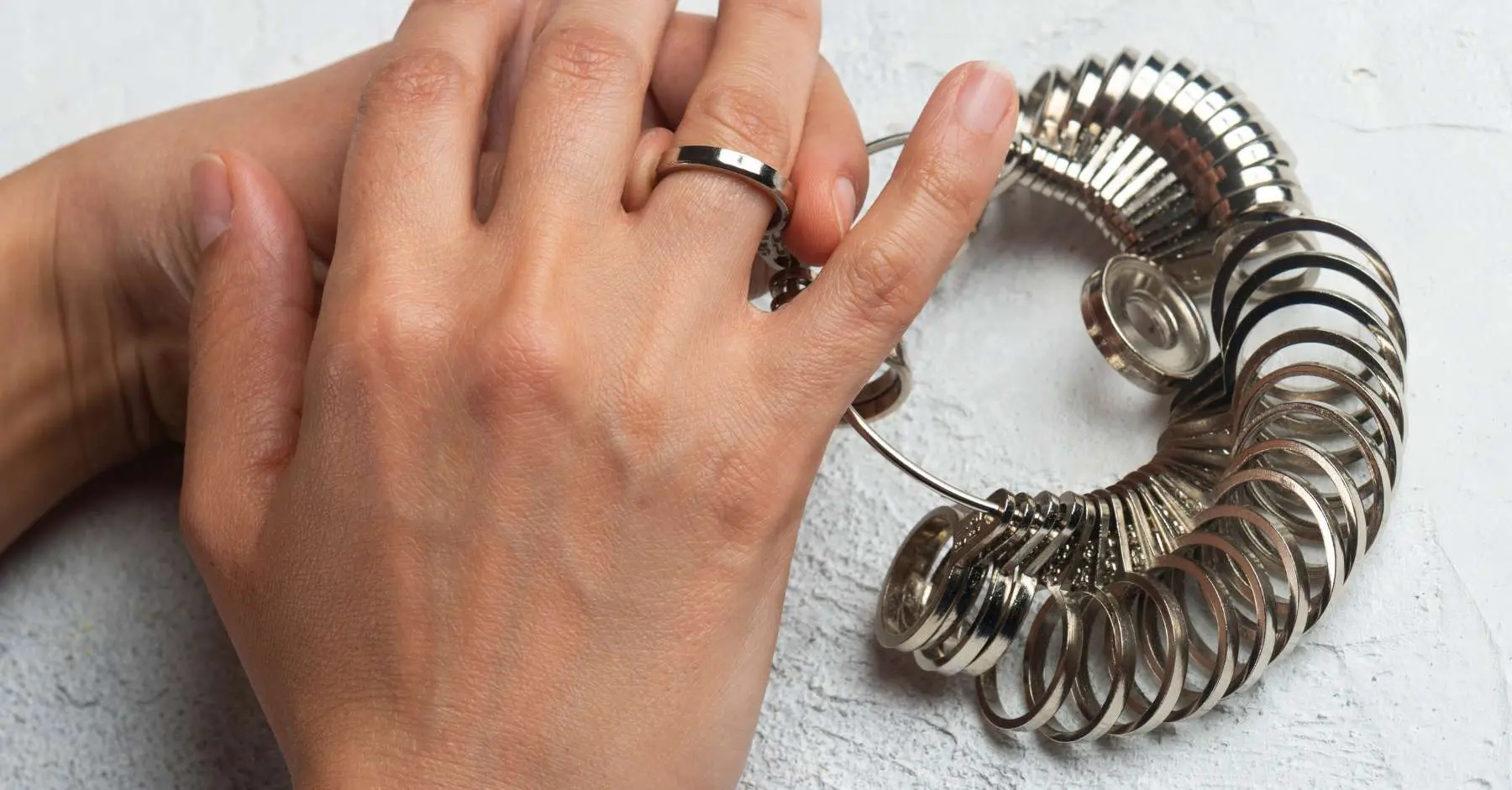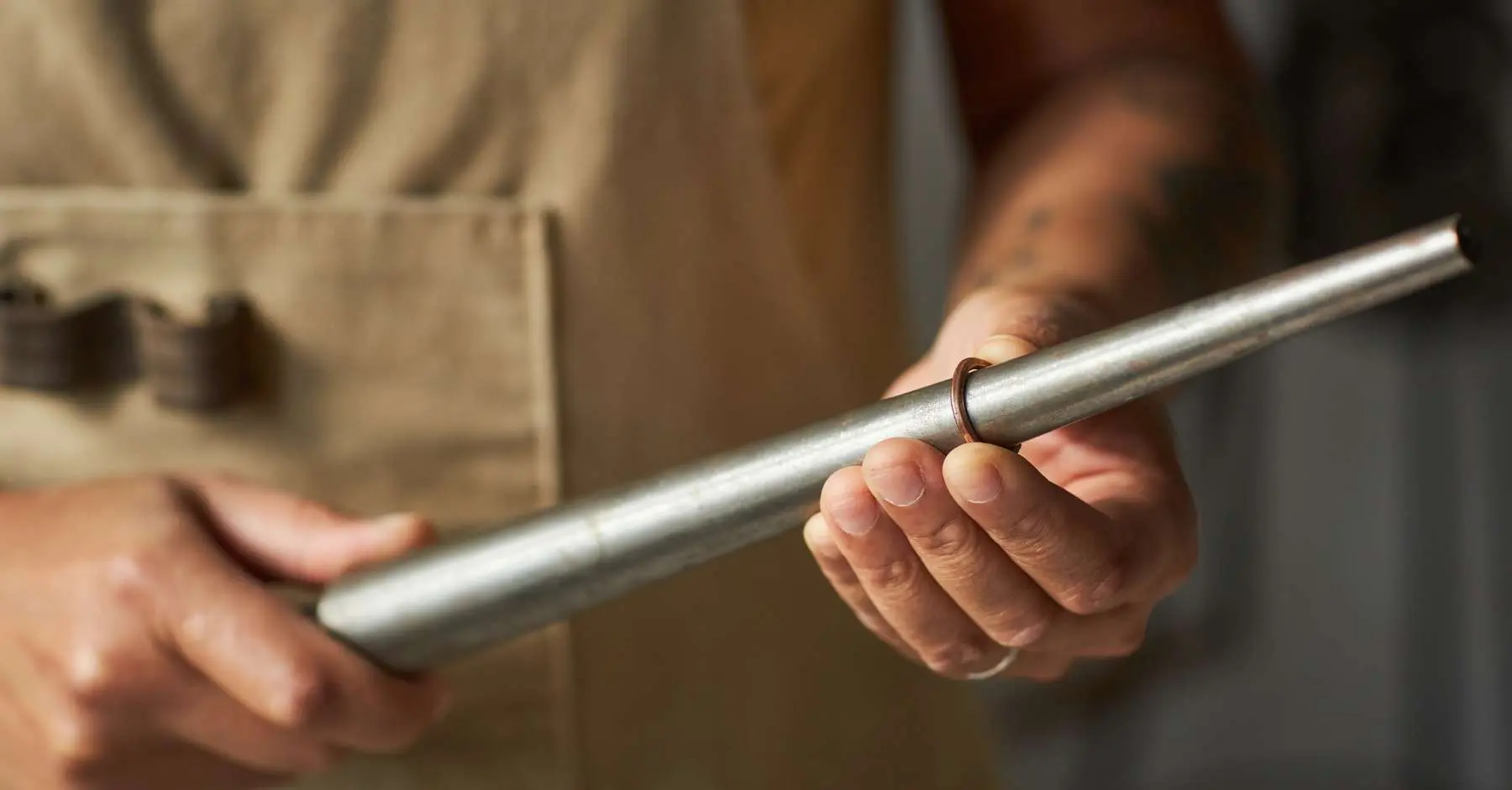Ring Sizing Guide
Unsure of your ring size? DiamondNet's guide reveals all! Discover how to measure your finger at home, decipher ring size charts, and find the perfect fit for any ring.

Find Your Perfect Fit: Ring Sizing Guide + Ring Size Chart
You’ve found the ring of your dreams (or are planning to propose to the love of your life!). But before you pop the question or click “add to cart,” one crucial step is ensuring the perfect fit. A ring that’s too loose can slip off and get lost, while a tight ring can be uncomfortable and even restrict blood flow.
At DiamondNet, we want your ring to symbolize love and joy, not frustration. That’s why we’ve created this comprehensive ring sizing guide to help you find the perfect fit from the comfort of your home. With our easy-to-follow tips and tricks, you’ll be a ring-sizing pro in no time!
Understanding Ring Size
Ring size is measured in millimeters (mm) and refers to the inner circumference of a ring. It represents the diameter of your finger that the ring needs to slide over comfortably. Here’s a breakdown of some key points to remember about ring size:
Finger size can fluctuate: Your fingers can swell slightly throughout the day due to temperature or activity level. Measuring your finger size later in the day is recommended when it’s likely closest to its “normal” size.
Not all fingers are created equal: Measuring the finger wearing the ring is essential. Your dominant hand’s ring finger might be a slightly different size than your non-dominant hand.
Consider knuckle size: Some rings, particularly those with wider bands, must fit comfortably over your knuckle joint and the base of your finger. If your knuckle is significantly larger than the base of your finger, consider opting for a half size larger to ensure smooth passage over the knuckle.
Now that we understand the basics, let’s explore different methods for measuring your ring size at home!
The Strength and Shine of Platinum: A Luxurious Choice How to Measure Your Ring Size with String: A Simple DIY Method
Ready to put those ring-sizing basics into action? Let’s dive into our first method: using string or floss! This is a convenient and easy way to measure your finger size at home. Here’s what you’ll need:
String or dental floss
Pen
Ruler or measuring tape (with millimeters)
Ring size chart (see below or find one online)
Ring Sizing Tips
- Choose the right time: As mentioned earlier, finger size can fluctuate. For the most accurate measurement, try measuring later when your fingers are likely at their normal size. Avoid measuring when your fingers are cold or swollen.
- Wrap it snug but comfortable: Take a piece of floss or string and carefully wrap it around the base of your chosen finger. Make sure it’s snug but not constricting. Mark the spot on the string where the ends meet perfectly with a pen.
- Measure and convert: Gently unwind the string and lay it flat on your ruler or measuring tape. Measure the distance between the mark you made and the end of the string in millimeters (mm). This measurement represents the circumference of your finger.
- Find your corresponding ring size: Since ring size is based on diameter, you can calculate it by dividing the circumference you measured by pi (3.14). However, most ring-size charts allow you to skip this step! Simply match the circumference in millimeters you measured to the closest corresponding ring size on a standard ring size chart. You can find these charts online or printed on many jeweler websites.
Finding the Correct Ring Size: Print-and-Cut Method
Our following method utilizes a printable ring sizer for those who prefer a visual approach! This is an excellent option if you’re unsure about using string or find it easier to visualize actual ring sizes.
What you’ll need:
- Printer and standard 8.5″ x 11″ paper
- Scissors

Finding the Correct Ring Size
Download and Print: Locate a printable ring size chart online with a sizer template. Ensure your printer settings are set to “100%” scaling for accurate measurements.
Cut with Care: Carefully cut out the ring sizer and the designated slot following the provided instructions.
Wrap and Match: Take the paper ring sizer and snugly wrap it around the base of the finger on which you intend to wear the ring. The numbers on the sizer should be facing upwards for easy reference. Insert the pointed end of the sizer through the slot you cut out to form a circle.
Match and Note: Look for the number on the sizer that lines up perfectly with the slit you created. This number corresponds to your ring size in millimeters! Remember, most ring size charts also offer quarter sizes. If your measurement falls between whole and half sizes, a quarter size might be your perfect fit.
Top Tip:
Print multiple copies of the ring sizer on the same sheet of paper to save time and materials.
This method offers a visual way to find your corresponding ring size. However, similar to the string method, remember that a comfortable fit is crucial. If you’re between sizes, especially for wider bands, consider opting for the slightly larger size to ensure smooth passage over your knuckle.
Browse our online collection or visit one of our Vancouver showrooms to experience the brilliance of DiamondNet rings firsthand. Our friendly staff is eager to assist you on your ring-finding journey!
Operation Ring Size: Cracking the Code with Existing Jewelry
Figuring out your loved one’s ring size can feel like a detective mission! While we recommend getting their exact measurement whenever possible, there are subtle ways to gather clues from their existing jewelry collection. Remember, this method is best for a surprise!
Mission Briefing: Gather intel! Casually browse their jewelry box when they’re not around. Look for rings they wear regularly – these are likely a good size reference.
Operation Measure: Once you’ve identified a suitable ring, borrow it for a covert sizing operation. Use a ruler to measure the inside diameter of the band in millimeters (mm). A millimeter ruler is ideal, but a standard ruler can work in a pinch.
Double Agent Data: For extra intel, measure a few rings they own to see if the sizes are consistent. This can help you determine if they have a standard size across their fingers or if there’s any variation.
Understanding Ring Sizes: A Sizing Chart Breakdown
Now that you’ve mastered measuring your finger at home, let’s delve into understanding ring size charts! These charts translate your finger circumference in millimeters (mm) to the corresponding standard ring size numbers.
Ring Size Chart
| Millimeters (mm) | Ring Size |
| 14 | 3 |
| 14.4 | 3.5 |
| 14.8 | 4 |
| 15.2 | 4.5 |
| 15.6 | 5 |
| 16 | 5.5 |
| 16.5 | 6 |
| 16.9 | 6.5 |
| 17.3 | 7 |
| 17.8 | 7.5 |
| 18.2 | 8 |
| 18.6 | 8.5 |
| 19 | 9 |
| 19.4 | 9.5 |
| 19.8 | 10 |
| 20.2 | 10.5 |
| 20.6 | 11 |
| 21 | 11.5 |
| 21.4 | 12 |
| 21.9 | 12.5 |
| 22.3 | 13 |
| 22.8 | 13.5 |
Generally, U.S. and Canada ring sizes range from size 3 to 13.5 for adults, with each half-size increment increasing by 0.4 millimeters in diameter. Here’s a breakdown to help you visualize:
Ring size 3: 14 millimeters (mm) in diameter
Ring size 3.5: 14.4 millimeters (mm) in diameter
Ring size 4: 14.8 millimeters (mm) in diameter
Stuck Between Sizes? No Problem!
Ah, the in-between zone! You’ve measured your finger, consulted the ring size chart, and landed between two sizes. What now?
When in doubt, size up! Tight rings can be uncomfortable, restrict blood flow, and even be challenging to get over your knuckle. Remember, your fingers fluctuate throughout the day, so opting for the slightly larger size ensures a comfortable fit for most occasions.
You can try temporary solutions at home if you have a slightly loose ring. These include using ring guards or transparent comfort strips, which can add a bit of extra snugness. However, it’s important to remember that these are temporary fixes. For a long-term solution, a professional jeweler’s touch is recommended.
Many jewelers, including DiamondNet, offer rings in quarter sizes and standard half sizes. If a half size feels too big or too small, consider inquiring about a quarter size for a more precise fit.
Cracking the Ring Size Code: International Conversions
While the U.S. standard ring size system is widely used, other sizing systems are worldwide. Here’s a quick guide to help you convert between some of the most common ones:
U.S. Standard (U.S.): We’ve focused on this system throughout this guide. It uses a numbered scale with half-size increments.
Millimeters (mm): This measurement reflects the diameter of the ring’s inner circle. It’s a universal unit that can be used to compare ring sizes across different systems.
Europe (E.U.): The European system uses whole numbers corresponding to the ring’s inner circumference in millimeters. To convert from U.S. size to E.U. size, you’ll need to find the circumference of your finger in millimeters (using the methods we covered) and then consult a conversion chart.
United Kingdom (U.K.): The U.K. system uses lettered sizes (e.g., A, B, C) with half-size increments. Conversion charts can help you translate between U.S. sizes and U.K. sizes based on the millimeter measurement of your finger.
Ring Size Guide for Women
Women’s rings typically range from size 3 (14 mm) to size 9 (19 mm) in diameter. However, this can vary depending on individual finger size. The average ring size for women falls between sizes 5 and 7, but it’s important to remember that these are just averages.
Ring Size Guide for Men
Men’s rings generally range from 8 (18.2 mm) to 14 (23 mm) in diameter. The average ring size for men is typically between size 10 and 11, but this can vary.
There Isn't a Single "Standard" Ring Size, But We Can Help You Find Yours
While there are undoubtedly popular ring sizes for both men and women, it’s important to remember that finger sizes can vary significantly from person to person. So, there isn’t one definitive “standard” ring size.
Here’s a helpful guideline to get you started:
Women’s rings: Typically range from size 3 (14 millimeters) to size 9 (19 millimeters) in diameter. The most popular sizes for women are 6, 6.5, and 7.
Men’s rings: Generally range in size from 8 (18.2 millimeters) to 14 (23 millimeters) in diameter. The most common sizes for men are 10, 10.5, and 11.

Finding the Perfect Fit
While ring size charts provide a helpful reference, it’s important to remember that comfort is critical. If you’re between sizes, especially for wider bands, opting for the slightly larger size is recommended to ensure the ring glides comfortably over your knuckle.
Which Method is Best for Finding Ring Size?
So, you’ve explored the different ring sizing methods we’ve covered – measuring with string, using a printable ring sizer, and even borrowing clues from existing jewelry. But with all these options, which one reigns supreme?
The truth is, there’s no single “best” method. The ideal approach depends on your comfort level, access to tools, and desired level of accuracy. Here’s a breakdown to help you choose:
DIY at Home:
- String Method: This is a convenient and budget-friendly option, perfect for those with readily available string or floss. However, some precision is required when measuring and marking the string.
- Printable Ring Sizer: This visual approach provides a more concrete reference point than string. However, printing inconsistencies or slight variations in how you wrap the sizer around your finger can affect accuracy.
Taking Inspiration from Existing Rings: While this method is an excellent option for surprise gifts, it assumes that the existing rings fit perfectly. It’s also important to be discreet and act quickly when “borrowing” their jewelry!
Discover Your Perfect Ring at DiamondNet
Now that you’ve unlocked the secrets of ring sizing, it’s time to explore the dazzling world of DiamondNet rings! Whether you’re searching for the ideal engagement ring to symbolize your love, a stunning statement piece to elevate your style, or a timeless gift to celebrate a special occasion, DiamondNet has something for everyone.
We boast a curated collection of exquisite rings featuring a variety of:
Precious metals:
From the timeless elegance of platinum and white gold to the warmth of yellow gold and the modern allure of rose gold, we offer a range of metals to suit your taste and preferences.
Gemstones:
Dive into a world of dazzling gemstones, including sparkling diamonds, colorful sapphires, radiant emeralds, and captivating gemstones for every birthstone and preference.
Styles:
Our collection encompasses a variety of styles, from classic solitaires and elegant halos to intricate vintage-inspired designs and modern geometric pieces. There's a ring to match every personality and style.
Book Your Free Consultation
Appointments curated just for you. Start your stack, find your fit, design the perfect piece.
Want to Sell your Gold?
Please fill out the form, and we will be in touch promptly.